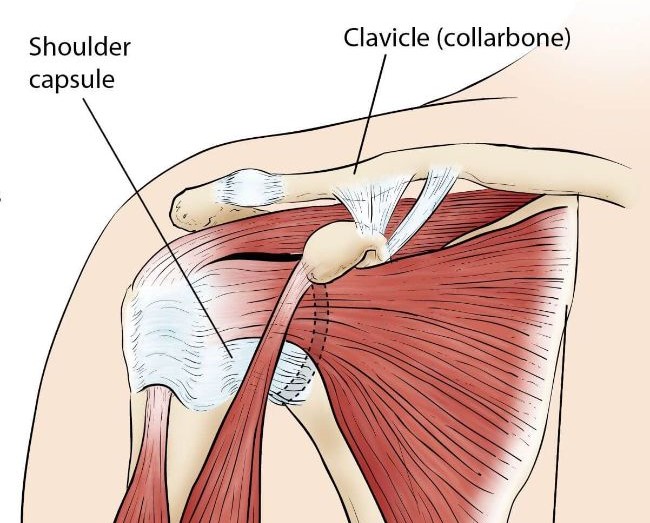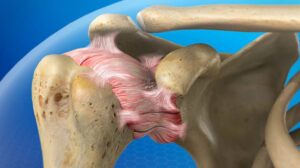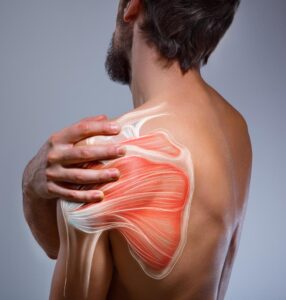The condition known as frozen shoulder can result in severe shoulder pain and restricted shoulder motion. A “stiff shoulder” can frequently cause the shoulder joint to lose all function and range of motion.
When scar tissue forms around the shoulder joint, the soft tissue of the shoulder joint starts to stiffen and compress, leading to frozen shoulder. Loss of mobility is caused by adhesions or scar tissue. As shoulder discomfort and stiffness worsen over time, the shoulder is moved less frequently. In certain situations, the discomfort and loss of motion can get so bad that going about daily tasks might become challenging.

Causes of Frozen Shoulder
A Frozen shoulder occurs when the capsule surrounding the shoulder joint becomes thickened and tight. This leads to a lack of flexibility and range of motion in the joint. The exact cause of frozen shoulder is unknown, but certain factors can increase the risk of developing this condition. These risk factors include:
- Age: Frozen shoulder most commonly occurs in people aged between 40 and 60, with women being more prone to the condition than men.
- Diabetes: Individuals with diabetes are more likely to develop frozen shoulder.
- Immobilization: Prolonged immobilization of the shoulder due to injuries, surgeries, or other medical conditions can increase the risk of developing a frozen shoulder.
Frozen Shoulder Symptoms:
The primary indications include pain and stiffness, hindering or preventing movement. Expect a dull or achy sensation in one shoulder, possibly extending to the muscles around the arm’s top and upper arm. Nighttime exacerbation of pain can disrupt sleep.
Frozen Shoulder Stages:
Typically, there are three phases in a frozen shoulder.
- Freezing Stage:– Shoulder pain occurs with movement, worsening gradually and often more pronounced at night.– Movement becomes limited.– Duration: 6-9 months.
- Frozen Stage:– Pain may alleviate, but stiffness intensifies.– Shoulder movement becomes increasingly difficult, hindering daily activities.– Duration: 4-12 months.
- Thawing Stage:– Range of motion begins to improve, returning to normal.– Duration: 5 months to 2 years.
How is a frozen shoulder diagnosed?
No specific test exists for frozen shoulder. Diagnosis involves a physical examination by your doctor, assessing pain during arm movements and noting any differences when they move your shoulder.
An anesthetic injection in your shoulder may be administered to numb the area for better assessment of your range of motion, termed an injection test. Typically, a physical exam suffices for diagnosing frozen shoulder, though imaging tests like X-rays, ultrasound, or MRI might be ordered to rule out other conditions such as arthritis or a torn rotator cuff.
Treatment
Frozen shoulder often improves without surgery, but it can take up to 3 years. The main goals are pain management and restoring motion and strength through physical therapy.
1. Non-surgical Approaches:
- Most individuals with frozen shoulders find relief through simple treatments.
- Addressing underlying health conditions, such as diabetes, can expedite recovery.
- Non-steroidal anti-inflammatory drugs (NSAIDs), like aspirin and ibuprofen, are effective in reducing pain and swelling.
2. Steroid Injections: Cortisone, a potent anti-inflammatory medication, is injected directly into the shoulder joint.
3. Hydrodilatation: If other nonsurgical methods fail, hydrodilatation involves gently injecting sterile fluid into the shoulder joint to expand and stretch the capsule. It can be performed by various specialists using imaging for guidance.
4. Physical Therapy: Specific exercises, supervised by a physical therapist or conducted at home, aid in restoring motion. These may include stretching or range of motion exercises, sometimes preceded by heat therapy to loosen the shoulder. Consult your healthcare provider for exercise recommendations.
5. Surgical Intervention: If therapy and conservative methods fail to alleviate symptoms, surgery may be considered after discussing with your doctor. It’s crucial to weigh the potential for recovery with simple treatments against the risks of surgery.
Surgery for a frozen shoulder is typically recommended during “Stage 2: Frozen.” The objective is to stretch and release the stiffened joint capsule. Common procedures include manipulation under anesthesia and shoulder arthroscopy.
- Manipulation under anesthesia involves inducing sleep while the doctor forcibly moves the shoulder, stretching or tearing the capsule and scar tissue to increase range of motion.
- Shoulder arthroscopy entails cutting through tight sections of the joint capsule using small instruments inserted through minor incisions around the shoulder.
Often, a combination of manipulation and arthroscopy is utilized for optimal results. Most patients experience favorable outcomes following these procedures.
How long does rehabilitation take?
Supervised physical therapy typically spans one to six weeks, with visits occurring one to three times weekly. Home exercises and stretching are essential throughout recovery, with stretching exercises recommended once or twice daily. Frozen shoulder typically resolves almost entirely with time and adherence to the treatment plan, which can take six to nine months for some patients, though shorter for others. Regaining internal rotation (moving the hand to the back pocket or up the middle of the back) often takes the longest.
When is surgery considered?
If the aforementioned program fails to improve the range of motion and alleviate pain, surgery may be necessary. Under general or regional anesthesia, the physician may manipulate the shoulder in the operating room to break down scar tissue. Alternatively, an arthroscope—a small instrument with an attached camera—may be used to directly cut or release the capsular adhesions. Physical therapy often begins the same day or the day after manipulation.
Additional procedures, such as spur removal, may also be required during manipulation. While some of these procedures can be performed arthroscopically, others may necessitate one or two larger incisions (open surgery) around the shoulder.
